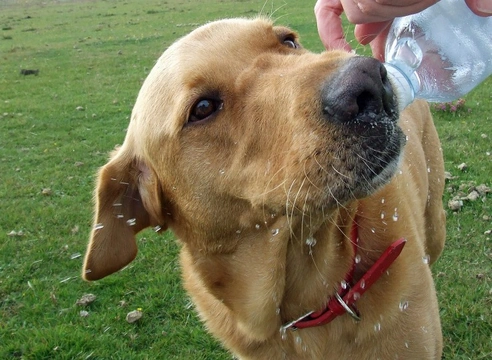
The Importance of Hydration for Dogs
Typically, a human being can last 3 to 4 days without water, even up to 7 days, but that is extreme. Dogs will become distressed much earlier than that, with a maximum span of only 3 days in all cases.
With the incredibly hot summer we had in 2018, the weather was potentially life threatening for dogs that did not drink enough water. Just like human beings, water is essential to promote and sustain healthy cells and organs, and to keep blood flowing through their bodies. Dogs lose water in the same way as we do, by sweat, panting, urinating, sickness or bowel movements. This bodily fluid must be replaced regularly throughout the day in all weather conditions.
Is there a guide to how much water dogs should drink?
In theory yes, there is. It does depend on the factors above – for instance if dogs are vomiting or have excessive diarrhoea, they can need more water to replenish what they are using. Another important point is to watch how much your dog is drinking, as there could be underlying illnesses that cause them to drink excessively, or the reverse, if they are not drinking much at all. Over drinking, (hyponatremia) can be as dangerous as under drinking, so importance should be placed on looking for these key signs, that may indicate that your dog is potentially unwell.
If your dog is over drinking, it could be a sign of diabetes or an infection. If your dog ‘gollops’ back water at a huge rate, this can also cause bloating, which is extremely uncomfortable for them. Under drinking could also be a sign of quite a few viruses (such as parvo) or indicative of organ problems, such as pancreatitis. This is by no means meant to be frightening, but it really is wise to be aware of their drinking habits.
Does weight and size make a difference to water consumption?
Weight certainly does. There is a general rule that your dog should drink between 15ml to 30ml per 0.5kg in weight, or around that level. If you have chosen, for instance, to feed your dog on a vegetarian diet, then it could be slightly lower than the optimal level, as a percentage of water gleaned from vegetables can be taken into consideration.
My dog isn’t a fan of water – will any other liquids suffice?
Bone broths are a really good idea, as they also gain nutrients from the content. Intersperse broths with water bowls for a healthy solution. Do try making your own though, they are far tastier than shop bought broths. Add a little parsley or other herb to keep it interesting!
Believe it or not, some dogs don’t like the taste of water! There are products available to flavour water with chicken or other meat, but this should not be used as a replacement for good clean water. Give them both, and eventually they will learn to regulate their plain water intake. Dilute the broth gradually so that the actual water content increases over a period of a few weeks.
Puppies get a great start in life due to their mother’s milk, but they do still need water once they have left their mums. In the early days, they have no concept of the fact they need to drink water, but as dogs age into adulthood, they are pretty smart!
It is quite sensible not to have just one water station for your pet, try to have at least two or even three strategically placed around the house where his or her favourite areas are. It will encourage them to drink if they keep seeing their bowls. Some dogs are intelligent enough to tell you when their bowls are empty, by banging them or nosing them across the floor!
Are there any other ways to check if my dog is dehydrated?
Yes, the skin test is a very good indication of whether your dog is dehydrated. By this, we mean extending a piece of skin behind your dog’s head (on the neck) and then releasing it. It should snap back easily into place if hydration is at the correct level. If not, it will very slowly go back, and be slightly elevated due to lack of movement in the skin. You can also back this up with checking the gums, which should be wet and healthy. Run a finger round your dog’s gums to feel if there is any stickiness or mucus-like feeling present.
Things to remember!
If you have a dog that never tires however much you exercise them, it is important that they get to drink during exercise. If there is no clean water available on his favourite place to go, take water with you, as they will be using up much more fluid than normal due to sweating, panting and marking their territory with urine – they need to top up on water during the run, and at the end.
There are ways to carry water that are very convenient. Fold up waterproof bowls are very useful, particularly if you have water fountains available on the walk, or alternatively take a bottle of water with you and tip into the bowl. Some companies sell convenient bottles for refreshing your dog, that have a small receptacle that drops down from the top of the bottle to use for replenishment. Quite convenient.
Think of all the times that lack of water could be dangerous for your dog (such as long car journeys) and be mindful of keeping your best friend hydrated.



